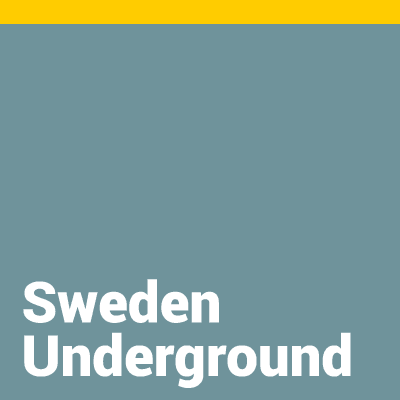Henriksdal Wastewater Treatment Plant
The municipal water company, Stockholm Vatten, has played a significant role in a growing Stockholm since 1861, when the first water treatment plant was built and households began to connect directly to the public water supply. Over the subsequent decades, the increased demand for water services resulted in deterioration of the water quality of Lake Mälaren. To protect the health of the residents and the safety of the water source, more sophisticated wastewater treatment was needed.
One result was Henriksdal, the first wastewater treatment plant in the world to be built in rock. However, the rapid growth of Stockholm and increasingly stringent requirements for wastewater treatment have meant that the plant have later required modification and expansion, and new wastewater tunnels were required.

Why underground?
When Henriksdal WWTP was built in the 1930s, it was more cost-effective to build in rock than above ground. Building underground also enabled the facility to be extended later, without using up valuable land.

Because the plant is built in rock, it is not affected by land exploitation and densification of the urban environment above. Siting the facility close to the source of the wastewater means there is less inflow of extraneous water, which improves the efficiency of treatment.
The area footprint of the plant is minimised by building it at several levels in the rock. The treatment basins can be made considerably deeper than usual, as they are blasted out of rock. The naked rock surface can be used instead of constructing concrete basins, which reduces costs.
By placing the WWTP underground, the impact of noise and odour is minimised. Activities at the plant have very little impact on the surroundings, and virtually all that is visible is a chimney and the administration building. Flats and houses could therefore be built very close to the plant, and the nearby residential area, Henriksdalsringen, was built on top of the plant in the 1960s.
Subsequent expansion
The WWTP was built between 1936 and 1941. Plant capacity was doubled in 1953, and the facility was extended in 1963–1970 with the addition of new basins for biological treatment in aeration tanks. In the 1990s, the aeration tanks were deepened from 5 to 12 m, thereby optimising the existing facility without requiring new rock caverns.

Henriksdal WWTP today
Henriksdal WWTP now comprises two facilities, Henriksdal and Sickla, which are connected by two 1-km tunnels. The plant serves 800,000 people from Stockholm and surrounding municipalities. The main purpose of the plant is to reduce eutrophication and oxygen deficiency in the recipient, Lake Saltsjön, and the Baltic Sea.
Stockholm Future Wastewater treatment (SFA)
In the SFA project, Henriksdal is being extended to double the treatment capacity to serve 1.6 million people and to comply with new, more stringent treatment requirements.
The expansion includes a new underground facility for pre-treatment under the Hammarbybacken ski slope in Sickla and a complete upgrade of the Henriksdal plant. Some new excavation will be needed, and a new sludge treatment facility will be built in the rock. The SFA project includes several complicated rock constructions, and blasting must be carefully controlled to ensure continuous operation of the treatment process and minimise disturbance to surrounding infrastructure and housing.
Stockholm Vatten also runs Bromma WWTP which is to be decommissioned at the end of the SFA project. This will release land for development, which is one of the aims of the SFA project and one of the benefits of building facilities underground. Wastewater will be conveyed to the extended Henriksdal WWTP in the new 14-km Bromma Tunnel, also blasted in the rock under Stockholm.
Bromma Tunnel
The new wastewater tunnel will connect to the existing Järva tunnel at a depth of 26 m, pass under Lake Mälaren to the Eolshäll pumping station, and finally connect to the new Sickla plant at a depth of 46 m. The route allows several emergency sewer overflow points to be connected to the tunnel, significantly reducing the pollution load to Lake Mälaren in periods of extreme rainfall.
The design horizon for the wastewater tunnel is at least 100 years and it will be built as a blasted rock tunnel, with a cross-sectional area of approximately 21 m2.
The tunnel will be constructed from ten fronts, using traditional blasting technology and pre-grouting.
As far as possible, the tunnel will largely be built under municipal land and below existing tunnels to minimise inconvenience to local residents. The route has been adapted to limit the impact on groundwater in the area.
Project Facts
| Project type | Wastewater treatment plant |
|---|---|
| Time of Construction | (1) 1936-1941 (2) Extended to double capacity 1953 (3) Extended for biological treatment and pre-treatment, Sickla facility built 1963-1970 (4) Extension for nitrogen removal 1992-1997 (5) Facility for external organic material, new mechanical treatment in screens and sandtraps 200–2011 (6) Extended to double capacity/more stringent treatment requirements 2015-2025 |
| Project size | The original treatment plant completed in 1941, cost SEK 6.3 million |
| Excavated rock (m3) | 1941, approx. 90.000 2015, approx. 1.500.000 |
| Owner | Stockholm Vatten och Avfall, the City of Stockholm (98%) and Huddinge municipality (2%) |
|---|
Contact
Two-thirds of households in Stockholm have access to a car, and around 15 percent of road surfaces are used for parking. Space is at a premium in the city, so there is a strong case for replacing roadside parking with underground car parks. ...
The municipal water company, Stockholm Vatten, has played a significant role in a growing Stockholm since 1861, when the first water treatment plant was built and households began to connect directly to the public water supply. ...
The route of the West Coast Line over the Hallandsås Ridge had been a bottleneck for nearly a century....





